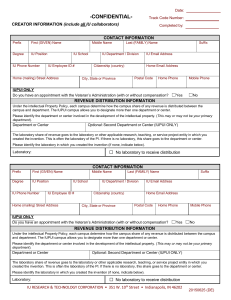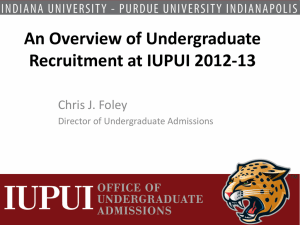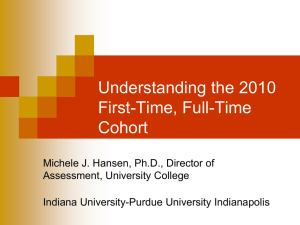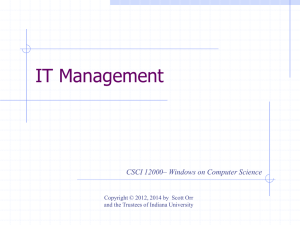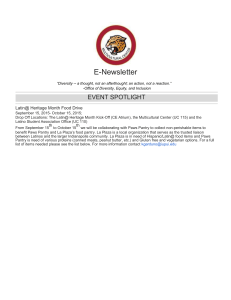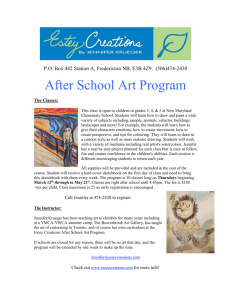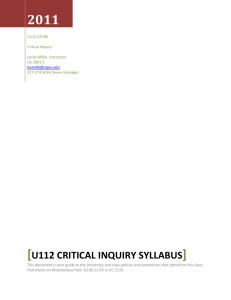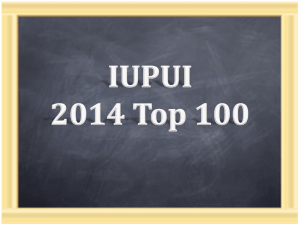RISE Action Plan Report - Division of Undergraduate Education
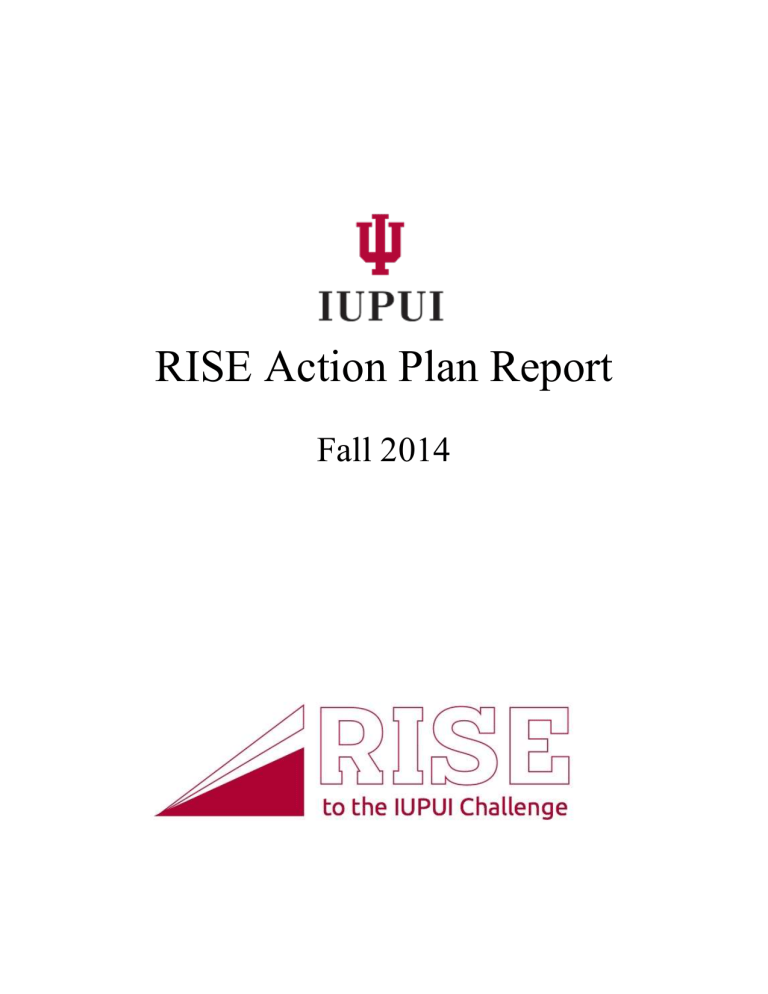
RISE Action Plan Report
Fall 2014
Executive Summary
A Subcommittee of the Council on Retention and Graduation Steering Committee reviewed the RISE program in spring 2013. The committee acknowledged the value of the program and commended its ability to enhance student learning and success. Recommendations were made on how to address existing program challenges, which included lack of faculty leadership, poor communication about RISE to faculty, inability to trace an accurate number of student participants, and the need to be able to assess student learning and programmatic outcomes. A team consisting of the newly appointed RISE director and five faculty/staff attended the AACU conference on HIPs, June 2014 at Vanderbilt University, with the charge of creating an action plan that would address the recommendations made by the CRG subcommittee. The following summarizes the short, mid, and long-term goals of a
“ working draft
”
of the action plan.
Goal #1: Develop a plan to elevate the visibility and awareness of RISE and communicate the value of
RISE and HIPs to multiple audiences.
Develop a full scale communications plan
Communicate the value of RISE to faculty, staff, students, and other constituents where RISE is not seen as a marketing strategy but of grave benefit to student success
Redefine who delivers RISE experiences in a more inclusive term: Educational Agents
Goal #2: Build greater fidelity of the RISE initiative to the initial model and intent.
Develop a technical communication plan to ensure that clearer understanding of course designations, their significance, and how they may be used to increase retention and graduation rates
Create advisory and operational support structure that provides holistic oversight and guidance for the RISE initiative
Goal #3: Establish system for ongoing Assessment and Design of RISE experiences.
Strengthen existing programs to promote intentional design and assessment of HIPs in RISE
Establish campus-wide assessment practices that regularly disaggregate student data in order to monitor fidelity and accessibility
Better articulate the relationship between RISE practices and institutional prescribed student learning outcomes (PULS)
Develop a research agenda for HIPs at IUPUI
Goal #4: Integrate RISE experiences as a fully developed and essential component of the campus strategic plan to be an “Anchor institution” that contributes to the well-being of the citizens of
Indianapolis, the state of Indiana, and beyond.
Work with co-curricular and lifelong learning initiatives to establish relationships between RISE and community anchor goals
Rise to the Challenge, IUPUI—June 2014
Continuing the Growth of High Impact Practices
AACU Conference 2014: Team IUPUI
Sarah Baker
Mary Price
Jennifer Thorington Springer
Rick Ward
Dawn Whitehead
Elee Wood
In order to continue the growth of High Impact Practices (HIPs), it is critical to pay attention to retention, graduation, equity and inclusion. Dramatic improvements in IUPUI’s retention and graduation rates have occurred over the last fifteen years, but in recent years the rate of progress has changed. Numerous studies have indicated the association between student engagement in high impact practices, such as those included in the
RISE to the IUPUI Challenge initiative and student persistence to graduation. This impact is especially evident among first generation, low-income and new majority students. Thus, one of the problems faced by our institution is how we increase the access and equitable distribution of these high impact practices in such a way that we benefit the students who most need the assistance, and in the process improve their chances of obtaining their degrees.
Vision
IUPUI to be the premier higher education system promoting distinctive quality education through high-impact practices.
Mission
To provide all students with broad access to quality education through inclusive and equitable high-impact practices that result in transformative student learning in support of timely graduation and prepare students to become actively engaged and informed citizens ready to participate in a global society.
Background
The RISE to the IUPUI Challenge initiative emerged in 2008 through a strategic planning process aimed at developing the IUPUI Academic Plan under the leadership of former Chief Academic Officer, Dr. Uday
Sukhatme. A planning committee presented its recommendations to the IUPUI community in 2008 and the initiative was formally launched in Fall 2009. RISE challenges all IUPUI undergraduates to complete at least two of four possible experiences as components of the baccalaureate degree: 1) credit-bearing undergraduate research experiences that augment students’ understanding of research, scholarship, and creative activities; 2) study abroad curricular experiences that enhance students’ learning and understanding of the world; 3) service learning courses that enhance students’ commitment to civic engagement; and 4) credit-bearing experiential learning experiences, such as internships, practica, clinical or fieldwork experiences. Until 2012, the RISE
Initiative was coordinated by the former Associate Vice Chancellor for Academic Affairs, Dr. Mary Fisher, who also helped to oversee competition for funds to support the development of new RISE courses provided by the
Office of Academic Affairs.
The RISE initiative initially was viewed as a means of branding an IUPUI undergraduate degree through
‘signature experiences’ that all undergraduates would receive. It also helped to recognize existing campus strengths, particularly in the areas of service learning and undergraduate research, and serve as a means of strengthening engagement in internships and study abroad. In the inaugural fall semester of 2009, 839 courses
were designated as RISE experiences across 14 IUPUI schools conferring undergraduate degrees. A detailed history of the launch of the RISE initiative is documented by Baker, Fisher, and Johnson (2012).
1
While there is no doubt that mentored research, international experiences, service learning and other forms of experiential learning are beneficial to student success and persistence, there are a number of other high-impact practices (e.g., experiences with diversity, themed learning communities, writing across the curriculum, first year seminars, capstones, eportfolios) that are excluded by the RISE framework. It is important that faculty continue to champion the importance of student engagement in a diverse array of high-impact practices, while at the same time advocating RISE as a means of enhancing IUPUI student learning and success.
Strategic Planning Process in 2012-2013:
In fall, 2012, the Steering Committee for the Council on Retention and Graduation launched a subcommittee aimed at addressing some challenges that were perceived to have arisen since the launch of the RISE initiative.
This subcommittee was comprised of leaders from relevant centers (e.g., Center for Research and Learning,
Office of International Affairs, Center for Service and Learning, University College Office of Career Planning and Development, and the Solution Center) as well as key campus partners, and was chaired by Kathy Johnson as responsibility for RISE had been added to the Associate Vice Chancellor for Undergraduate Education responsibilities in 2012. The group met regularly between December 2012 and March 2013.
Parallel to the work of the strategic planning committee, a team of faculty has been working on ways of expanding faculty leadership for RISE and enhancing faculty development related to high-impact practices.
This group was convened through the FACET Leadership Institute and has been led by Dr. Sarah Baker, who participated on an IU-system team that attended the AAC&U Summer Institute on High-Impact Practices at
Portland State University in 2012. Since August, 2012, Sarah Baker, Gina Gibau, and Angie McNelis from
IUPUI and Gary Felsten and Kathy Wills from IUPUC have been engaging in a needs analysis related to the
RISE initiative and convening focus groups with administrators, curriculum committee chairs, and faculty members, some of whom have received funding to develop RISE courses in the last several years. This work is ongoing and is expected to complement the recommendations made in this report.
Current Challenges:
The work of these faculty/staff groups revealed a number of critical issues that must be addressed to ensure that high impact practices including those comprising the RISE challenge are broadly available, and inclusive of students who will most benefit from the experiences.
1. RISE to What End? There needs to be clearer articulation and communication that the purpose of RISE is to engage students in transformative experiences that will prepare them for their civic and professional lives in an increasingly global world . At the moment, it is not clear whether the initiative is a marketing strategy or an initiative aimed at enhancing student learning, persistence, and success. Communications must be systematically and strategically deployed to students, faculty and staff. While RISE is heavily emphasized in
Orientation, Bridge and First Year Seminars, it is unlikely that the message is received by transfer students or returning adult students, or reinforced as students move into their majors. Similarly, faculty has not been targeted for communications campaigns and it is unlikely that newer faculty are well versed in the purpose and goals of the RISE initiative. At this time, it is not clear why students would be that motivated simply to have
RISE experiences transcripted, or why faculty would want to engage in course development in support of the initiative.
1 Baker, S., Fisher, M.L., & Johnson, K. E. (2012). RISE to the IUPUI Challenge: High impact practices focused on students’ success. Metropolitan Universities Journal, 23(1), 29-39.
2. Counting and Tracking of RISE participants : Currently the Registrar’s Office is counting a) courses designated as R, I, S, and E each semester (including summers), and b) upon graduation, the number of students that have completed various combinations of RISE experiences – see http://registrar.iupui.edu/risechallenge.html
. At the same time, there is significant concern that these efforts are not capturing accurately the degree to which students are truly engaged in RISE experiences, and furthermore, lack of disaggregated student data prevents us from fully documenting the impact of RISE experiences across diverse student groups. It is likely that there is both over counting and undercounting going on, which makes program evaluation based on these data nearly impossible to complete. As a result of both the propensity for undercounting and over counting in the Registrar’s data, the Center for Research and Learning, the Study Abroad office, and the Center for
Service and Learning maintain their own internal records of participation rates. These databases tend not to connect with other ‘warehouses’ for institutional data due to a lack of coordination between centers, thus rending institutional research very challenging. Internship participation is not being tracked systematically at all, although some data are maintained by the Solution Center and annual reports have been compiled by the
Career Services Council. However, many internships are offered as non-credit, and students do not earn “E”
RISE designations for participation in them.
3.
RISE does not capture the many High Impact Practices available to students on this campus.
Clearly, there are experiences on campus that fit the definition of a high-impact practice (e.g., summer research experiences) for which no designation is used because the experiences are not credit-bearing, and there may be other practices that may demonstrate the qualities of high-impact practices (e.g. sports, student employment) that have not be assessed nor defined.
4. Faculty ‘Ownership’ of RISE : RISE currently is perceived by some faculty as a “top-down” initiative with which they have had little involvement. It is also perceived by some as a tactic for “branding” and marketing an undergraduate degree. While RISE simply reframes the excellent work in which faculty and students were already engaged at IUPUI, there does seem to be some benefit to a communications campaign to promote better understanding, as well as involving more faculty in helping to shape the future of the RISE initiative. Further efforts to support all members of the IUPUI community (including faculty of all levels, advising, staff, centers, etc.) as educational agents who implement RISE experiences will serve to deepen the collective knowledge and aid in refining and strengthening knowledge of high-impact practices.
5. Assessing Student Learning: We assume that the transcripting of the RISE experience serves to document the learning that students engage in. Yet, it is likely that students engage in deep learning even when participating in 0-credit alternatives (e.g., summer research, internships). Careful attention must be paid to the methods and procedures used to document student learning in RISE experiences; and more efforts to document the impact of these experiences on student subgroups is imperative. The ways that schools determine whether a course should be linked to RISE varies greatly, and it would be helpful to apply criteria more consistently.
Documentation of equitable and inclusive student learning and demonstrating whether this learning is sufficient to be awarded credit has never before been wrestled with. Though journaling and reflections (stored in eportfolios) have tremendous potential for helping to document student learning, they are not used consistently across RISE courses.
6. Evaluation and Assessment : Inaccurate counting and tracking of RISE experiences renders institutional data unreliable. There is limited data to demonstrate the relationship between the RISE experiences and student learning outcomes. Until we are certain that RISE courses are being delivered consistently, there’s great difficulty in evaluating short- and long-term student learning outcomes across campus, and particularly across disaggregated groups. Several years ago there was a RISE evaluation task force, but these efforts were difficult to sustain and there is little consistency in how student learning is being assessed.
Why Review and Reconsider RISE in 2014 and Beyond?
There is no question that the RISE initiative creates opportunities for undergraduate students and enhances the image of the campus. It also clearly builds on existing strengths in experiential forms of learning in our undergraduate curricula, some of which have been recognized through national awards (e.g., US New and
World Report excellence in service learning programs, TLCs; Presidential Honor Roll for Community
Engagement). A number of additional benefits and opportunities seem evident:
In broad terms, IUPUI seeks to be an anchor institution where “we can be forces for change, not only improving our own prospects but also our neighborhoods and communities in a sustained way”
2
. RISE is uniquely situated as a major strategy of IUPUI’s goals to become a stronger anchor institution by improving the learning outcomes for all students and by more actively demonstrating the role of RISE experiences in bringing about that change in our community.
RISE scholarships have been one of the most successful targets for the recent IUPUI Impact campaign.
Since announcing the RISE Scholarships in 2010, donors have established endowments to support more than 60 RISE scholarships campus-wide.
There is a burgeoning literature on the positive effects of engaging in intentionally designed high-impact practice on student learning, persistence, and success. These benefits are particularly significant when experiences are coupled together (e.g., international service learning) and for students from underrepresented groups. However, IUPUI has not systematically studied or investigated the extent of high-impact practices across all student groups including students of color, first-generation students, adult, and transfer students. Establishing a curriculum program that allows for the scaffolding of student engagement and experiences with multiple HIPs to measure the longer-term impact of student success will be of great use.
IUPUI has developed a national reputation in the area of STEM education, and external funding is available to help expand opportunities for undergraduate research. This may be an area to target for more in-depth examination of the high-impact practices in relation to equitable student achievement.
The IUPUI Office for International Affairs led IUPUI’s participation in the ACE Internationalization
Lab through spring 2014 and it is clear that students’ engagement in international experiences is highly valued. Resources to support study abroad and other forms of international experiences are expected to increase. This, too, is an opportunity for further, more in-depth study of the relationship between transformative student learning and equitable participation.
As the state’s public, urban research institution positioned in the state’s capital, ample opportunities for internships and service learning exist, particularly related to health and life science sectors. Strategic planning is underway in order to take full advantage of these opportunities and to coordinate the development of employer relations in the metropolitan Indianapolis region.
IUPUI Career EDGE (Exploration, Development, Graduation, and Employment) is an emerging initiative reflecting President McRobbie’s call for expanded academic advising and career development support for Indiana University students. External funding to support the launch of Career EDGE has been received through the Lilly Endowment Inc., and participation in RISE experiences is intended to support students’ career exploration and development across all undergraduate degree programs.
The ePDP (Personal Development Plan) portfolio has integrated the RISE initiative into reflection questions aimed at helping students to articulate what they will learn through engaging in high-impact practices. These reflections are aimed at enhancing students’ ability to compete for internships and jobs, and to deepen their learning. There are opportunities to further connect the ePDP data to examine the role of these practices in providing equitable and inclusive transformative learning for IUPUI students.
2 Bantz, C. (2010). From the Desk of the Chancellor, June 14, 2010. Retrieved from http://newscenter.iupui.edu/index.php?id=4708
The Future of RISE: 2014 and Beyond
3
Goals, Objectives, Action, Products/Outputs, Outcomes
Goal #1: Develop a plan to elevate the visibility and awareness of RISE and communicate the value of
RISE and HIPs to multiple audiences.
Objective (1) : Develop a marketing plan that will document, explore, and expand the definition of RISE experiences across campus
Action: Develop a full-scale communication plan
A.
Talking points/fast facts o RISE highlights o You-Tube o Website design o Videos (check with Honors) o New logo o Continue with RISE acronym, with an add-on that addresses more HIPs or create new brand?
→ Who: Jennifer working with Communications and Eric Sickles
→ Timeframe: short-term
B.
Communicating the value of RISE to prospective and current students along with faculty/staff
→ Who: Jennifer
→ Timeframe: mid- to long-term
C.
Plan to communicate value of RISE to external business and the community
→ Who: Jennifer and Kathy
→ Timeframe: long-term
Objective (2): Create better campus visibility and presence of RISE
Action: Office Space. (Leverage resources of advisory council if necessary).
→ Who: Jennifer and Kathy
→ Timeframe: short-term
Objective (3): Shift definition of who delivers RISE experiences to more inclusive term such as educational agent
Action:
A. Develop inclusive language into RISE communications that recognizes that “educator” in the context of RISE experiences is broader than the term “faculty”—can include staff, advisors, and community partners.
→ Who: Jennifer, Steering Committee, Advisory Council
→ Timeframe: long-term
B. Leverage the existing Educational Agents and their networks who facilitate RISE experiences to build ownership with EA groups (FACET, RISE grant recipients)
→ Who: Jennifer
→ Timeframe: mid- to long-term
3 Short term – 6 months
Mid term – 6 months to 1 year
Long term – greater than 1 year
C. Open course development grant program to non-tenure track faculty (with permission from department chair)
→ Who: Jennifer and Advisory Council
→ Timeframe: short-term
Objective (4): Conduct series of meetings with key campus offices and centers to coordinate efforts to promote
RISE experiences to underrepresented groups. Who is currently being served? Initial data is needed to know where we stand.
Action: Better understanding of who is being served and those we need to reach out to.
→ Who: Jennifer, GA, OSDAE
→ Timeframe: short-term
Products/Outputs:
Articulate definitions of RISE experiences
Fact sheets on how to RISE
Launch event for still we RISE
EA HIP institute
Outcomes:
Common understanding and use of HIPS/RISE practices by EAs increases across campus
Schools using designations and tools to revise curriculum to reflect RISE goals
Greater % of new students and EAs getting involved in RISE activities
Underrepresented students see themselves within RISE expectations
EAs intentionally insure inclusion of underrepresented students in RISE experiences
Staff see themselves as co-educators within RISE experiences
More inclusive professional development programming developed that furthers understanding of and use of HIPs across diverse instructional roles
Improves quality of RISE course delivery
Inclusivity—stronger programming and reaching a wider audience.
Goal #2: Build greater fidelity of the RISE initiative to the initial model and intent.
Objective (1) : Develop a course monitoring system that builds campus capacity to effectively track, assess and evaluate the quality of RISE experiences appropriate for program evaluation, including disaggregation of data, and tracking
Action: Work with the Registrar, the new OSDAE group and related Centers to:
A. Develop a technical communication plan that helps to: o Build understanding of the designations o Why they matter o How they can be of use to depts./schools seeking to increase retention and graduation rates o Clarify distinctions between community-based and experiential learning o Experiential and community based learning experiences
→ Who: Jennifer with Centers staff (Mary, Stephanie, Elizabeth, Marybeth)
→ Timeframe: short-term
B.
Explore other means of recognition (badges) for additional HIPs (co-curricular
transcript, e-portfolio, etc.)
→ Who: Advisory Council, Registrar, Steering Committee
→ Timeframe: long-term
Objective (2): Create advisory and operational support structure that provides holistic oversight and guidance for the RISE initiative
Action: Advisory Council will be existing CRG RISE sub-committee
A.
Identify Steering Committee members, representing broad spectrum of
faculty/staff/students
→ Who: Jennifer, Kathy
→ Timeframe: short-term
B. RISE Fellows/Scholars/Ambassadors (stipend)
→ Who: Jennifer, Advisory Council
→ Timeframe: long-term
Products/Outputs:
Curriculum map (connect with assessment and design)
RISE curriculum plan (connect with assessment and design)
Improved designations
“Clean” course lists
Approval process
Outcomes:
EAs plan intentional student outcomes using RISE criteria
Schools and departments begin to shift course offerings and articulate relationship of course outcomes to
RISE expectations
EAs make conscious decisions about how RISE experiences are developmentally appropriate within programs
Goal #3: Establish system for ongoing Assessment and Design of RISE experiences.
Objective (1) : Strengthen existing programs to promote intentional design and assessment of HIPs in RISE.
Action: Create educational agent opportunities along with leadership opportunities in the development of course-level, school level, and campus level assessments and design
A.
Review existing RISE course development grant processes to align with goals
→ Who: Jennifer, Advisory Council, and Steering Committee
→ Timeframe: short-term
B.
Inventory other complimentary professional development opportunities (grants, scholarships, workshops, etc.) offered for RISE experiences across campus (i.e. by other Centers and offices)
→ Who: Jennifer with Centers staff (for CSL –Mary, CRL, OIA, etc.)
→ Timeframe: short- to mid-term
C.
Create RISE events calendar that is linked with that in the CTL to cross-promote RISE professional development opportunities
→ Who: Jennifer with GA and Tech Support
→ Timeframe: short-term
Objective (2): Establish campus-wide assessment practices that regularly disaggregate student data in order to monitor fidelity and accessibility
Action:
A.
Strengthen relationship with CTL o Identify and develop development opportunities o Meet with CTL to discuss partnerships and development opportunities o Develop online opportunities o Include curriculum development and curriculum mapping
→ Who: Jennifer and Advisory Council
→ Timeframe: mid-term
B.
Identify and cultivate faculty/staff leadership and support for RISE and director
→ Who: Jennifer and Advisory Council
→ Timeframe: short- to mid-term
Objective (3): Better articulate the relationship between RISE practices and institutional prescribed student learning outcomes (PULs)
Action: Examine potential differential impact of HIPs or RISE on students of color, first generation, and transfer students
→ Who: Jennifer and Michelle Hansen
→ Timeframe: long-term
Objective (4): Develop a research agenda for HIPs at IUPUI
Action: Work with PRAC on reporting/role discrepancies between RISE courses and PUL matrices
→ Who: Jennifer, Michelle Hansen, and Sarah
→ Timeframe: long-term
Products/Outputs:
NSEE data
Institutional PUL Data
E-portfolio assessments
Outcomes:
Regular reports are broken out by key demographics available to campus community
Reports are used for continuous improvements of RISE programming
Assessment outcomes will be used to measure summative achievement data on student learning through
RISE experiences
Goal #4: Integrate RISE experiences as a fully developed and essential component of the campus strategic plan to be an “Anchor institution” that contributes to the well-being of the citizens of
Indianapolis, the state of Indiana, and beyond.
Objective (1) : Work with co-curricular and lifelong learning initiatives to establish relationships between RISE and community anchor goals
Action:
A.
Set-up meeting with administrators in student affairs and in community engagement and lifelong learning to examine co-curricular activities in light of literature on HIPs (co-curricular service, scholarships, leadership and mentoring programs, etc.)
→ Who: Jennifer with Chad Ahren, Zeb Davenport, Julie Hatcher, Khaula Murtadha, and
others
→ Timeframe: short-term*
B.
Inventory co-curricular programs that are intentionally designed with the attributes of HIPs
→ Who: Jennifer to request form from program directors, student life representative(s)
→ Timeframe: mid-term
C.
Inventory participation rates by new majority students in co-curricular versus curricular HIPs
→ Who: Jennifer, GA, Student Life, Registrar
→ Timeframe: long-term
D.
Work with enrollment management and the division of community engagement to monitor retention and completion from neighborhoods and areas that IUPUI has longstanding commitments
(Near West, Martindale Brightwood)
→ Who: Jennifer
→ Timeframe: long-term
E.
Track participation in RISE experiences and outcomes for students identified in 1.D
→ Who: Jennifer
→ Timeframe: long-term
F.
Camps and community life educational agents—work with community engaged programs including CSL as well as others tasked with civic engagement activities
→ Who: Jennifer
→ Timeframe: long-term
Products/Outputs:
Experience/learning maps that link curricular and co-curricular learning via the use of HIPs
Transformative and engaged learning
“Out of the box” learning/community knowledge
Intentionality for RISE courses
Assessment of engaged learning
Outcomes:
Increased enrollment of students from neighborhoods and communities where IUPUI is engaged
Graduation rates increase among new majority students
Successful entry of IUPUI graduates into jobs and graduate programs
Increasing rate of IUPUI graduates and EAs contributing to the health and well-being and economic development of Indiana
Increased number or EAs who are actively contributing in community and have deep knowledge and training relative to community
Decreased barriers to access high education and successful completion of degrees
Decreased income disparity in neighborhoods and communities where IUPUI is engaged
